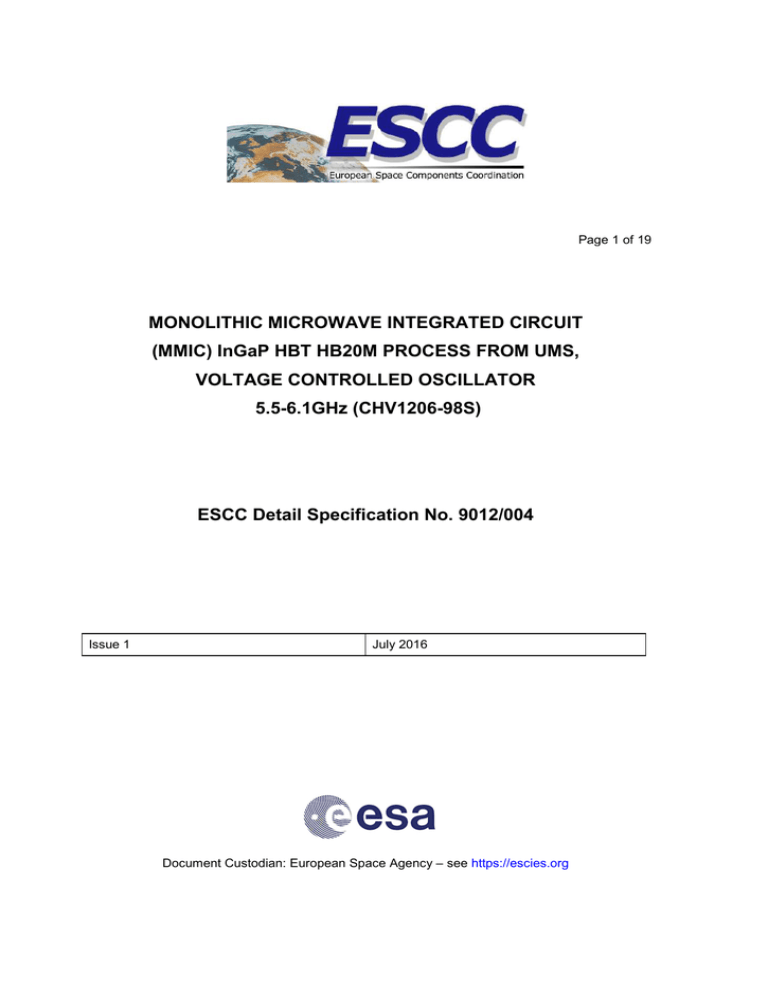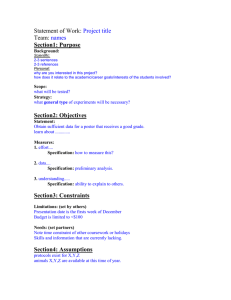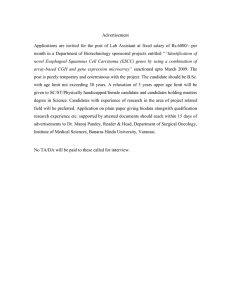
Page 1 of 19
MONOLITHIC MICROWAVE INTEGRATED CIRCUIT
(MMIC) InGaP HBT HB20M PROCESS FROM UMS,
VOLTAGE CONTROLLED OSCILLATOR
5.5-6.1GHz (CHV1206-98S)
ESCC Detail Specification No. 9012/004
Issue 1
July 2016
Document Custodian: European Space Agency – see https://escies.org
ESCC Detail Specification
PAGE 2
No. 9012/004
ISSUE 1
LEGAL DISCLAIMER AND COPYRIGHT
European Space Agency, Copyright © 2016. All rights reserved.
The European Space Agency disclaims any liability or responsibility, to any person or entity, with
respect to any loss or damage caused, or alleged to be caused, directly or indirectly by the use and
application of this ESCC publication.
This publication, without prior permission of the European Space Agency and provided it is not
used for a commercial purpose, may be:
−
−
copied in whole, in any medium, without alteration or modification.
copied in part, in any medium, provided that the ESCC document identification, comprising the
ESCC symbol, document number and document issue, is removed.
ESCC Detail Specification
PAGE 3
No. 9012/004
ISSUE 1
DOCUMENTATION CHANGE NOTICE
(Refer to https://escies.org for ESCC DCR content)
DCR No.
CHANGE DESCRIPTION
ESCC Detail Specification
PAGE 4
No. 9012/004
ISSUE 1
TABLE OF CONTENTS
1
GENERAL
6
1.1
SCOPE
6
1.2
TYPE VARIANTS
6
1.3
MAXIMUM RATINGS
6
1.4
PARAMETER DERATING INFORMATION
6
1.5
PHYSICAL DIMENSIONS
6
1.6
FUNCTIONAL DIAGRAM
6
1.7
HANDLING PRECAUTIONS
6
2
APPLICABLE DOCUMENTS
6
3
TERMS, DEFINITIONS, ABBREVIATIONS, SYMBOLS AND UNITS
7
4
REQUIREMENTS
11
4.1
GENERAL
11
4.2
DEVIATIONS FROM GENERIC SPECIFICATION
11
4.2.1
Deviations from Production Control – Wafer Lot Acceptance
11
4.2.2
Deviations from Production Control - Wafer screening (CHART II (a))
11
4.2.3
Deviations from Production Control - Wafer acceptance testing (CHART III (a))
11
4.2.4
Deviations from Final Production Tests (Chart II (b))
11
4.2.5
Deviations from Burn-in and Electrical Measurements (Chart III (b))
11
4.2.6
Deviations from Qualification Tests (Chart IV)
11
4.2.7
Deviations from Lot Acceptance Tests (Chart V)
11
4.3
MECHANICAL REQUIREMENTS
12
4.3.1
Dimension Check
12
4.3.2
Weight
12
4.3.3
Terminal Strength
12
4.3.4
Bond Strength
12
4.3.5
Die Shear
12
4.4
MATERIALS AND FINISHES
12
4.5
MARKING
12
4.5.1
General
12
4.5.2
ESCC Component Number
13
4.5.3
Pad Identification
13
4.5.4
Traceability Information
13
4.5.5
Packaging
13
4.6
ELECTRICAL MEASUREMENTS
13
4.6.1
Electrical Measurements at Room Temperature
13
ESCC Detail Specification
PAGE 5
No. 9012/004
ISSUE 1
4.6.2
Electrical Measurements at High and Low Temperatures
13
4.6.3
Circuits for Electrical Measurements
14
4.7
BURN-IN TESTS
14
4.7.1
Parameter Drift Values
14
4.7.2
Conditions for Burn-In
14
4.7.3
Electrical Circuit for Burn-In
14
4.8
ENDURANCE TESTS (CHART V OF ESCC GENERIC SPECIFICATION NO. 9010)
14
4.8.1
Electrical Measurements at Intermediate Points and on Completion of Endurance Tests
14
4.8.2
Conditions for Operating Life Test (Part of Endurance Testing)
14
4.8.3
Electrical Circuit for Operating Life Test
14
4.9
TOTAL DOSE IRRADIATION TESTING
14
4.10
SPECIAL TESTING
14
APPENDIX A
19
Figure 1 – PARAMETER DERATING INFORMATION
Figure 2 – PHYSICAL DIMENSIONS
Figure 3 – FUNCTIONAL DIAGRAM
Figure 4 – TEST CONFIGURATIONS FOR ELECTRICAL MEASUREMENTS [DUT IN JIG]
Figure 5 – ELECTRICAL CIRCUIT FOR BURN IN AND LIFE TEST
8
9
10
17
18
ESCC Detail Specification
PAGE 6
No. 9012/004
ISSUE 1
1
GENERAL
1.1
SCOPE
This specification details the ratings, physical and electrical characteristics, test and inspection data
for the Microwave Monolithic Integrated Circuit (MMIC), in die form, C-band voltage controlled
oscillator (VCO) referenced CHV1206-98S. The VCO2, based on the InGaP HBT HB20M process
from UMS, covers the frequency range from 5.5 GHz to 6.1 GHz. This document is based on, and
should be read in conjunction with ESCC Generic Specification No. 9010, the requirements of
which are supplemented herein.
1.2
TYPE VARIANTS
MMIC Variants of the basic type components specified herein, which are also covered by this
specification, are given in Table 1(a).
1.3
MAXIMUM RATINGS
The maximum ratings, which shall not be exceeded at any time during use or storage, applicable to
the component specified herein, are scheduled in Table 1(b).
1.4
PARAMETER DERATING INFORMATION
The power dissipation de-rating curve is shown in Figure 1.
1.5
PHYSICAL DIMENSIONS
The physical dimensions of the die and mechanical drawing specified herein are shown in Figure 2.
1.6
FUNCTIONAL DIAGRAM
The functional diagram, showing pad identification of the component specified herein, is shown in
Figure 3.
1.7
HANDLING PRECAUTIONS
These devices are susceptible to damage by electrostatic discharge. Therefore suitable
precautions shall be employed for protection during all phases of manufacture test, packaging,
shipping and handling.
These chips are categorized as Class 0 with a Minimum Critical Path Failure Voltage of 50V for this
Variant.
2
APPLICABLE DOCUMENTS
The following documents form part of this specification and shall be read in conjunction with it:
(a)
(b)
(c)
(d)
(e)
ESCC Generic Specification No. 9010 for Monolithic Microwave Integrated Circuits (MMICs)
MIL STD 883 Test Methods and Procedures for Microelectronics
ESCC 20600 Preservation, Packaging and Despatch of ESCC Components
ESCC 21300 Terms Definition, Abbreviations, Symbols and Units
ESCC 23800 Electrostatic Discharge Sensitivity Test method
3
ESCC Detail Specification
PAGE 7
No. 9012/004
ISSUE 1
TERMS, DEFINITIONS, ABBREVIATIONS, SYMBOLS AND UNITS
For the purpose of this specification, the terms, definitions, abbreviations, symbols and units
specified in ESCC Basic Specification No. 21300 shall apply. In addition, the following
abbreviations are used:
RTH (J-C)=Thermal Resistance, Junction to Case.
VC= Supply voltage.
IC=Supply current.
VT =Tuning voltage.
TABLE 1(a) – TYPE VARIANTS
(1)
VARIANT
(2)
TYPE
(3)
CASE
(4)
FIGURE
01
CHV1206-98S
CHIP
2
(5)
(6)
PAD METALLISATION
BACKSIDE FINISH
AND THICKNESS OF
(METALLISATION
TOP LAYER
AND THICKNESS)
Au, 3.3µm
Au, 4.5µm
TABLE 1(b) – MAXIMUM RATINGS(1)
No.
CHARACTERISTICS
1
Tuning voltage
VT
15
V
2
Supply voltage
VC
4
V
3
Supply current
IC
110
mA
4
Junction temperature
Tj
175
°C
5
Operating temperature range
Ta
-55 to +125
°C
6
Storage Temperature Range
Tstg
-55 to +175
°C
7
Soldering Temperature
Ts01
300
°C
AuSn 80/20 (see
AN001 UMS
application note)
8
Thermal resistance (2)
Rth
48.7
°C/W
Rth (J-C) @
125°C
mW
Continuous
Pdiss (T =
125°C)
(derate 5.4
mW/°C above
125°C)
10
Dissipated power
SYMBOL MAXIMUM RATINGS UNIT
Pdiss
270
REMARKS
Total current of
the circuit
With respect to
max Tj =175°C
NOTES
1.
Operation of this device above anyone of these parameters may cause permanent damage.
2.
For bare die mounted in appropriate package. Not a true maximum rating – for information
only.
ESCC Detail Specification
PAGE 8
No. 9012/004
ISSUE 1
FIGURE 1 – PARAMETER DERATING INFORMATION
Power dissipation de-rating curve
ESCC Detail Specification
PAGE 9
No. 9012/004
ISSUE 1
FIGURE 2 – PHYSICAL DIMENSIONS
NOTES
All dimensions are in micrometers
Chip size = 2770 x 2770 ±35µm
Chip thickness = 100µm ±10µm
RF pad = 110 x 200µm²
DC pads= 100 x 100µm²
Chip width and length are given with a tolerance of ±35µm
Pin name
Description
VT
Tune Voltage
VC
Supply Voltage
RF
Output RF
ESCC Detail Specification
PAGE 10
No. 9012/004
ISSUE 1
FIGURE 3 – FUNCTIONAL DIAGRAM
ESCC Detail Specification
PAGE 11
No. 9012/004
ISSUE 1
4
REQUIREMENTS
4.1
GENERAL
The complete requirements for procurement of the bare MMIC die specified herein shall be as
stated in this specification and ESCC Generic Specification No. 9010 for Monolithic Microwave
Integrated Circuits (MMIC).
The test requirement for the MMIC lot validation shall be performed on mounted MMIC samples
submitted to Burn-in and electrical measurements CHART III(b) and Lot Acceptance tests level 2
CHART V.
Deviations from the Generic Specification applicable to this specification only, are listed in Para.
4.2.
Deviations from the applicable Generic Specification and this Detail Specification, formally agreed
with specific Manufacturers on the basis that the alternative requirements are equivalent to the
ESCC requirements and do not affect the MMIC chip reliability, are listed in the appendices
attached to this specification.
4.2
DEVIATIONS FROM GENERIC SPECIFICATION
4.2.1
Deviations from Production Control – Wafer Lot Acceptance
(a)
Total Dose Radiation Testing: not required
4.2.2
Deviations from Production Control - Wafer screening (CHART II (a))
(a)
Para. 9.5.2.1: applicable on 5 bare dies assembled on appropriate substrate
4.2.3
Deviations from Production Control - Wafer acceptance testing (CHART III (a))
(a)
Para. 9.7.1 and 9.7.2 only applicable
4.2.4
Deviations from Final Production Tests (Chart II (b))
(a)
Chart II (b) shall not be performed
4.2.5
Deviations from Burn-in and Electrical Measurements (Chart III (b))
(a)
Para. 9.15: shall not be performed.
(b)
Para. 9.16: shall apply as per condition MIL-STD-883, Test Method 1015, Test condition ‘B’.
Duration shall be 240 hrs, 125°C ambient.
(c)
Para.9.5.2.2: shall not be performed.
4.2.6
Deviations from Qualification Tests (Chart IV)
Chart IV shall not be performed.
4.2.7
Deviations from Lot Acceptance Tests (Chart V)
Chart V Level 2 – Endurance Subgroup plus electrical Subgroup shall apply.
Environmental/Mechanical Subgroups shall not be performed.
Deviations from the applicable Chart V level 2 to this specification are listed herein.
(a)
(b)
(c)
ESCC Detail Specification
PAGE 12
No. 9012/004
ISSUE 1
Level 3: Electrical measurements at room and high and low temperatures (-25°C/+80°C) on
3 samples per qualification lot shall be performed. Components Assembly and Capability
Tests shall not be performed.
Level 3 Special testing Para. 9.27 shall not be performed.
Level 2 Endurance Subgroup shall be performed on 10 samples. The operating life test
duration shall be 1,000 hours minimum at 125°C ambient or equivalent as per table 1 of
MIL-STD-883 Test method 1005.
4.3
MECHANICAL REQUIREMENTS
4.3.1
Dimension Check
The dimensions of the components specified herein shall be checked. They shall conform to those
shown in Figure 2.
4.3.2
Weight
The maximum weight of the components specified herein is negligible.
4.3.3
Terminal Strength
(a)
Shall not be performed
4.3.4
Bond Strength
The requirements for bond strength are specified in Section 9 of ESCC Generic Specification No.
9010. The test conditions shall be as described in MIL STD 883, method 2011, cond. D.
(a)
(b)
4.3.5
Die Shear
The requirements for die shear are specified in Section 9 of ESCC Generic Specification No. 9010.
The test conditions shall be as described in MIL STD 883, method 2019.
(a)
4.4
Condition: ‘D’.
Bond Strengths: 20 wires (5 dies, 4 wires per die, No defect allowed).
Minimum acceptable on die shear strengths: 2.5kg (on 5 parts, No defect allowed).
MATERIALS AND FINISHES
The materials and finishes shall be as specified herein. Where a definite material is not specified, a
material which will enable the components specified herein to meet the performance requirements
of this specification shall be used. Acceptance or approval of any constituent material does not
guarantee acceptance of the finished product.
Bond Pad Metallization and Back-side metallization is Au
4.5
MARKING
4.5.1
General
The marking of components delivered to this specification shall be in accordance with the
requirements of ESCC Basic Specification No. 21700 and the following paragraphs. When the
component is too small to accommodate all of the marking as specified, as much as space permits
shall be marked and the marking information, in full, shall accompany the component in its primary
package.
ESCC Detail Specification
PAGE 13
No. 9012/004
ISSUE 1
The information to be marked and the order of precedence shall be as follows:
(a)
(b)
(c)
(d)
The ESCC Component Number.
Manufacturer name or Symbol
Manufacturer Part Number
Traceability as defined in ESCC : Lot, Wafer, Date code …
The primary package shall bear an “ESD Sensitive” label.
4.5.2
ESCC Component Number
Each component shall bear the ESCC Component Number which shall be constituted and marked
as follows:
Detail specification Number: 9012004
Type Variant (see Table 1(a))01
Testing Level (B or C, as applicable) B
4.5.3
Pad Identification
Pad identification shall be as shown in Figure 2 of this specification.
4.5.4
Traceability Information
Each component shall be marked in respect of traceability information in accordance with the
requirements of ESCC Basic Specification No. 21700.
4.5.5
Packaging
An appropriate Gel-pak of glass filled black conductive polycarbonate with appropriate retention
level shall be used for delivery, so that for storage and shipment the parts are adequately safeguarded against mechanical or electrical injury during transportation to the ordered and:
•
•
•
•
•
Protected against deterioration due to humidity
Primary HS-shield metalized bag, partly filled with dry nitrogen and sealed
Secondary DRY-SHIELD metalized humidity proof bag with desiccant and humidity indicator,
partly filled with dry nitrogen and sealed
Suitable for storage in their primary package for a period of several months,
Easily identified after each stage of packaging
Furthermore the top side of the Gel-Pak shall be clearly identified. Appropriate Gel-Pak is VR76 CC
02 XL.
4.6
ELECTRICAL MEASUREMENTS
4.6.1
Electrical Measurements at Room Temperature
The parameters to be measured at room temperature are scheduled in Table 2. Unless otherwise
specified, the measurements shall be performed at Tamb = + 25±3°C.
4.6.2
Electrical Measurements at High and Low Temperatures
The parameters to be measured at high and low temperatures are scheduled in Table 3. Unless
otherwise specified, the measurements shall be performed at + 80°C and -25°C.
ESCC Detail Specification
PAGE 14
No. 9012/004
ISSUE 1
4.6.3
Circuits for Electrical Measurements
Circuits for use in performing electrical measurements listed in Table 2 and Table 3 of this
specification are shown in Figure 4.
4.7
BURN-IN TESTS
Burn-in shall be done in accordance with Chart III(b) of ESCC Generic Specification N° 9010.
4.7.1
Parameter Drift Values
The parameter and drift values applicable to Burn-In are specified in Table 4 of this specification.
Unless otherwise stated, measurements shall be performed at Tamb = + 25 ±3 °C. The parameter
drift values applicable to the scheduled parameters shall not be exceeded. In addition to these drift
value requirements, the appropriate limit value specified for a given parameter in Table 2 shall not
be exceeded.
4.7.2
Conditions for Burn-In
The requirements for Burn-In are specified in Section 9 of ESCC Generic Specification No. 9010.
The conditions for Burn-In shall be as specified in Table 5 of this specification.
4.7.3
Electrical Circuit for Burn-In
The circuit for use in performing the Burn-In test is shown in Figure 5 of this specification.
4.8
ENDURANCE TESTS (CHART V OF ESCC GENERIC SPECIFICATION NO. 9010)
4.8.1
Electrical Measurements at Intermediate Points and on Completion of Endurance Tests
The parameters to be measured at intermediate points and on completion of endurance testing are
scheduled in Table 2 of this specification. Unless otherwise stated, the measurements shall be
performed at Ta = + 25 ± 3 °C.
4.8.2
Conditions for Operating Life Test (Part of Endurance Testing)
The requirements for operating life testing are specified in Section 9 of ESCC Generic Specification
No. 9010. The conditions for operating life testing are specified in Table 5 of this specification.
4.8.3
Electrical Circuit for Operating Life Test
The circuit for use in performing the operating life test shall be the same as shown in Figure 5 of
this specification for burn-in.
4.9
TOTAL DOSE IRRADIATION TESTING
Not applicable.
4.10
SPECIAL TESTING
Not applicable.
ESCC Detail Specification
PAGE 15
No. 9012/004
ISSUE 1
TABLE 2 – ELECTRICAL MEASUREMENTS AT ROOM TEMPERATURE OF BARE DIE – DC &
RF PARAMETERS
LIMITS
No.
CHARACTERISTICS
SYMBOL
UNIT
MIN.
1
Frequency range
Freq
5.5
2
Output Power
Pout
6.5
3
TYP.
MAX.
6.1
GHz
8.5
dBm
Output Power Variation
vs VTune
1.2
dB
4
Phase Noise @ 10KHz
-78
dBc/Hz
5
Phase Noise @ 100KHz
-100
dBc/Hz
6
Tuning sensitivity
7
Tune Voltage
Vt
8
Supply Voltage
Vc
3
V
9
Supply current
Ic
75
mA
10
Tune Port leakage current
It
11
Output Return Loss
12 F0/2 harmonic suppression
100
275
MHz/V
0
10
V
1
10
µA
dB
-58
dBc
13
3F0/2 harmonic
suppression
-56
dBc
14
2F0 harmonic suppression
-28
dBc
ESCC Detail Specification
PAGE 16
No. 9012/004
ISSUE 1
TABLE 3 – ELECTRICAL MEASUREMENTS AT LOW AND HIGH TEMPERATURE OF BARE
DIE - DC & RF PARAMETERS
LIMITS
No.
CHARACTERISTICS
SYMBOL
UNIT
MIN.
1
Frequency range
Freq
5.5
2
Output Power
Pout
6
3
TYP.
MAX.
6.1
GHz
8.5
dBm
Output Power Variation
vs VTune
1.5
dB
4
Phase Noise @ 10KHz
-78
dBc/Hz
5
Phase Noise @ 100KHz
-100
dBc/Hz
6
Tuning sensitivity
7
Tune Voltage
Vt
8
Supply Voltage
Vc
3
V
9
Supply current
Ic
75
mA
10
Tune Port leakage current
It
15
Frequency Drift Rate
100
275
MHz/V
0
10
V
1
0.8
µA
MHz/°C
ESCC Detail Specification
PAGE 17
No. 9012/004
ISSUE 1
FIGURE 4 – TEST CONFIGURATIONS FOR ELECTRICAL MEASUREMENTS [DUT IN JIG]
TABLE 4 – PARAMETER DRIFT VALUES
No.
CHARACTERISTICS
SYMBOL
SPEC.
AND/OR
TEST
METHOD
2
Output Power
Pout
As per
Table 2
As per Table
2
+/-1
dB
8
Supply current
Ic
As per
Table 2
As per Table
2
+/-20
%
TEST
CONDITIONS
LIMITS
UNIT
ESCC Detail Specification
PAGE 18
No. 9012/004
ISSUE 1
TABLE 5 – CONDITIONS FOR BURN IN AND OPERATING LIFE TESTS
No.
CHARACTERISTICS
SYMBOL
VALUE
UNIT
1
Ambient Temperature
Tamb
+125
°C
2
Junction Temperature
Tj
+137
°C
3
Supply Current
Ic
82
mA
4
Supply biasing
Vc
3
V
5
Duration for Burn In
240
H
6
Duration for Life Test
1000
H
FIGURE 5 – ELECTRICAL CIRCUIT FOR BURN IN AND LIFE TEST
N°1
Capacitor 2.2µF
N°2
Capacitor 100nF
N°3
Capacitor 120pF
ESCC Detail Specification
PAGE 19
No. 9012/004
ISSUE 1
APPENDIX A
AGREED DEVIATIONS FOR UMS TECHNOLOGIES (D)
ITEMS AFFECTED
DESCRIPTION OF DEVIATIONS
Visual inspection
MIL STD 883, method 2010
SQ_10S_Visual inspection Specification for GaAs MMIC Level A
(internal UMS specification for Visual inspection; based on
Method 2010 condition A)
Recommended conditions for
die attach and wire bonding
UMS application note : AN0001 User guide for bare dies GaAs
MMIC storage, pick & place, die attach and wire bonding




